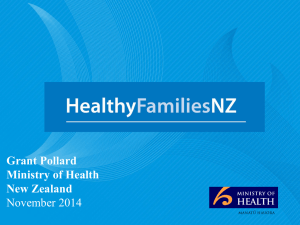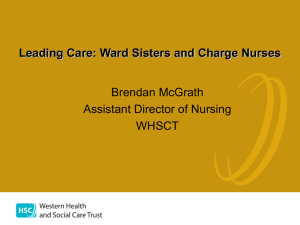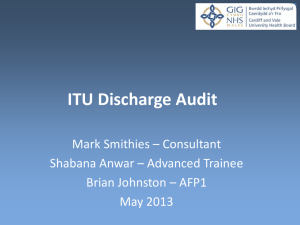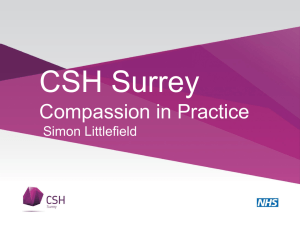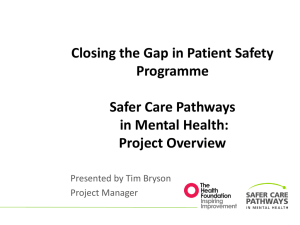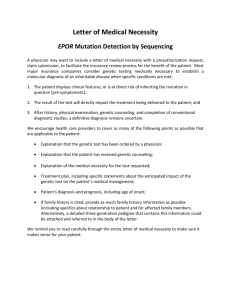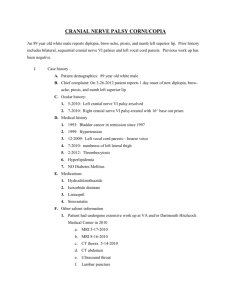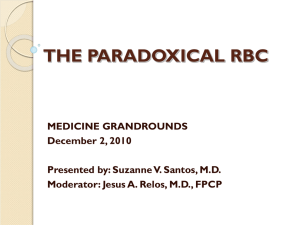Polycythemia Vera by Caroline Armas
advertisement
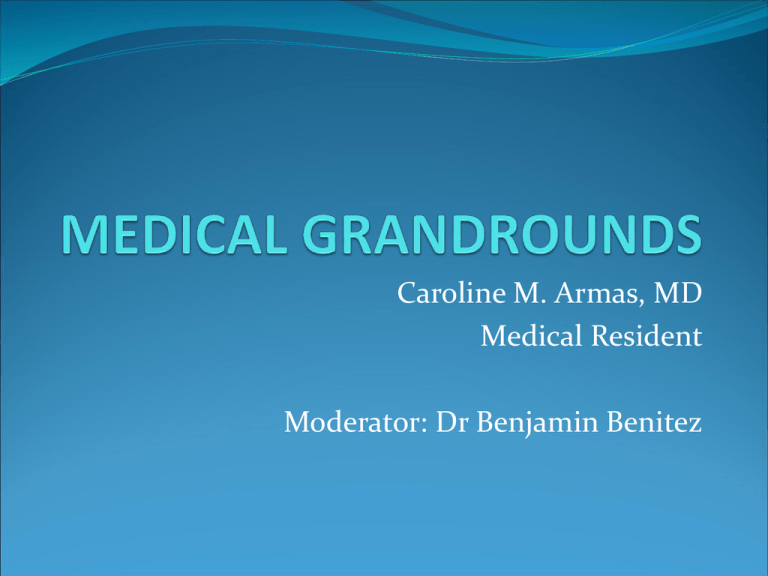
Caroline M. Armas, MD Medical Resident Moderator: Dr Benjamin Benitez OBJECTIVES • To present a case of a 52 year old male, who came in due to epigastric pain • To discuss a complication of Polycythemia Vera Identifying data • NDG • 52 year old, male • Married • Catholic • From Brgy. Valenzuela, Makati City • Admitted: October 16, 2010 History of present illness • Diagnosed with Polycythemia Vera (2006) • Rx: Hydroxyurea (Litalir); phlebotomy as needed • Epigastric pain, grade 10/10, nonradiating • Rx: Ranitidine, Pantoprazole and 2 weeks Aluminum/Magnesium • Persistence of abdominal pain Admission Review of systems • No fever, cough, colds • No chest pain, no difficulty of breathing • No dysuria, frequency, urgency Past medical history • Post Cerebrovascular accident (2006) • Acid Peptic Disease on AlOH2 + MgOH2 as needed Family history • No hypertension, diabetes, thyroid disorders • No history of cancer • Denies history of blood dyscrasia PERSONAL AND SOCIAL HISTORY • Previous smoker – stopped 2006 • 14 pack-year (10sticks/day for 28years) • Occasional alcoholic beverage drinker • 1-2 bottles of beer , 1-2x/month PHYSICAL EXAMINATION • Conscious, coherent, ambulatory, not in respiratory distress • BP 110/70 mmHg HR 72 bpm RR 19cpm T 36C • Ht 152cm Wt 81kg BMI 25.6 • Supple neck, no neck vein distention, • Symmetric chest expansion, clear breath sounds • Quiet precordium, normal rate, regular rhythm, apex beat at 5th ICS MCL, no murmurs Physical examination • Flat abdomen, normoactive bowel sounds, soft, (+) direct tenderness on epigastric area • No edema; Full and equal pulses • Neurologic examination: unremarkable Salient features 52/M Known case of Polycythemia vera Post cerebrovascular accident – no residuals (+) epigastric pain (+) direct tenderness on epigastric area Initial impression Acid Peptic Disease Acute pancreatitis Polycythemia Vera Post Cerebrovascular accident with no residual COURSE IN THE WARD 1st Hospital Day CBC, Amylase and Lipase Plain film of abdomen CT of whole abdomen (plain) Nothing per orem Pantoprazole 40mg IV once daily Octreotide 250mcg subcutaneous, followed by 750mcg IV drip Referred to Hematology service COURSE IN THE WARD CBC Hemoglobin Hematocrit WBC Segmenters Lymphocytes Eosinophils Basophils Monocytes Platelet count MCV MCH MCHC RDW 10.7 33.5 11.67 63 22 2 2 11 1267000 84.4 27 31.9 17 Amylase 48 Lipase 33.6 PFA October 16 2010 Course in the ward Plain CT scan of whole abdomen: Acute pancreatitis Minimal ascites Atherosclerotic disease of the abdominal aorta Acute Pancreatitis Most Common causes: Gallstones (30-60%) and Alcohol (15 to 30%) Abdominal pain is the major symptom Diagnosis: increased level of serum amylase CT scan may confirm the clinical impression of acute pancreatitis even in the face of normal serum amylase levels Polycythemia Vera Is a stem cell disorder Prominent feature: elevated absolute red blood cell count because of uncontrolled red blood cell production Increased white blood cell and platelet production due to an abnormal clone of hematopoietic stem cells with increased sensitivity to different growth factors of maturation COURSE IN THE WARD 3rd Hospital day Still with epigastric pain, grade 7/10 Repeat CBC Referred to Infectious Diseases service Blood culture Imipenem 250mg IV every 6 hours COURSE IN THE WARD CBC Hemoglobin Hematocrit WBC Segmenters Lymphocytes Eosinophils Basophils Monocytes Platelet count MCV MCH MCHC RDW 10.7 33.5 11.67 63 22 2 2 11 1267000 84.4 27 31.9 17 3rd HD 10.9 34.6 14.91 52 27 3 2 16 1342000 85.6 27 31.5 17.1 COURSE IN THE WARD 5th Hospital Day (+) abdominal pain, grade 2/10 CBC, CEA, AFP, CA 19-9 Diet: General liquids Hydroxyurea 500mg 2tabs 2x/day COURSE IN THE WARD CBC Hemoglobin Hematocrit WBC Segmenters Lymphocytes Eosinophils Basophils Monocytes Platelet count MCV MCH MCHC RDW 10.7 33.5 11.67 63 22 2 2 11 1267000 84.4 27 31.9 17 3rd HD 10.9 34.6 14.91 52 27 3 2 16 1342000 85.6 27 31.5 17.1 5th HD 11 35.4 14.84 55 18 13 2 12 978000 86.1 26.8 31.1 17 5th HD AFP (8.6) 1.41 CA19-9 (0-39) 4.81 CEA (0-5.5) 0.92 Hydroxyurea Is a nonalkylating agent that inhibits DNA synthesis and cell replication by blocking the enzyme ribonucleotide reductase resulting in a megaloblastic blood picture Onset of action is rapid, usually 3-5 days of initiation of treatment and effect is short-lived once medication is stopped Initial dose is 15mg/kg per day, taken in divided doses COURSE IN THE WARD 7th hospital day (+) abdominal pain, grade 5/10 CBC CT of whole abdomen with IV contrast CBC 3WARD HD 5 COURSE IN THE Hemoglobin 10.7 10.9 rd Hematocrit WBC Segmenters Lymphocytes Eosinophils Basophils Monocytes Platelet count MCV MCH MCHC RDW th 33.5 11.67 63 22 2 2 11 34.6 14.91 52 27 3 2 16 HD 11 35.4 14.84 55 18 13 2 12 1267000 84.4 27 31.9 17 1342000 85.6 27 31.5 17.1 978000 86.1 26.8 31.1 17 7th HD 11.3 36.4 13.17 56 27 8 934000 86.7 26.9 31 17.4 9 COURSE IN THE WARD CT of Whole Abdomen with IV contrast Portal vein thrombosis extending to the SMV. Minimal ascites which has slightly increased since the previous examination. Interval increase in the size of the gallbladder likely reactive in nature. Colonic diverticulosis Atherosclerotic abdominal aorta. Minimal right pleural effusion. Thrombosis in polycythemia vera Thrombosis is a frequent complication in persons with Polycythemia vera Result from the disruption of hemostatic mechanisms because of increased level of red blood cells and an elevation of platelet count. Significant risk factors for thrombosis History of prior thrombosis Age over 60 years old Prolonged exposure to substantial degrees of thrombocytosis Polycythemia Vera:The Natural History of 1213 Patients Followed for 20 Years Retrospective cohort Subjects: 1213 patients with polycythemia vera 14% had thrombotic events before diagnosis of polycythemia vera; and 20% had a thrombotic event as presenting symptom The Natural History of 1213 Patients Followed for 20 Years polycythemia vera Follow-up: Fatal thrombosis – arterial thrombosis (81%) and venous thrombosis (18%); Nonfatal thrombosis: Superficial thrombophlebitis (18.5%) Deep Vein Thrombosis (17.5) Myocardial infarction (14%) Ischemic stroke (9.5%) COURSE IN THE WARD 7th hospital day Blood C/S: no growth Imipenem was discontinued Referred to TCVS Baseline PT, PTT Heparin drip 10000 units to run for 24 hours Heparin Is an indirect thrombin inhibitor which complexes with antithrombin converting it from a slow to a rapid inactivator of thrombin. Limitation: narrow therapeutic window of adequate anticoagualtion without bleeding. Monitor response using aPTT Therapeutic level for first 24hours: 1.5times the control Maintenance: 1.5-2.5 times COURSE IN THE WARD Platelet count 1600000 1400000 1200000 1000000 800000 Platelet count 600000 400000 200000 0 Day 1 Day2 Day4 Day 5 Day 6 Day 8 Day 10 Day 11 COURSE IN THE WARD 12th Hospital day Therapeutic platelet reduction Repeat CBC COURSE IN THE WARD CBC 3rd HD 5th HD 7th HD 13th HD Hemoglobin 10.7 10.9 11 11.3 10.7 Hematocrit 33.5 34.6 35.4 36.4 34.4 11.67 14.91 14.84 13.17 8.54 Segmenters 63 52 55 56 55 Lymphocytes 22 27 18 27 24 Eosinophils 2 3 13 8 5 Basophils 2 2 2 Monocytes 11 16 12 9 6 1267000 1342000 978000 934000 623000 MCV 84.4 85.6 86.1 86.7 85.4 MCH 27 27 26.8 26.9 26.6 31.9 31.5 31.1 31 31.1 17 17.1 17 17.4 17.7 WBC Platelet count MCHC RDW Phlebotomy Mainstay of therapy of Polycythemia Vera Objective is to remove excess cellular elements to improve the circulation of blood by lowering blood viscosity. COURSE IN THE WARD 14th hospital day Minimal abdominal pain Chest heaviness ECG, cardiac enzymes referred to Cardiology service 2D-Echo Clopidogrel 75mg daily, Nicorandil 5mg 2x/day Trimetazidine 35mg 2x/day, Bisoprolol 2.5mg daily COURSE IN THE WARD ECG Probable old inferior wall MI Nonspecific ST-Twave changes 2D-Echo Interventricular septal hypertrophy with hypokinetic posterior and inferior walls from mid to apex. Mildly depressed left ventricular systolic function with EF of 52%. Mild mitral tricuspid and pumonic regurgitation. Normal pulmonary artery pressure. Doppler evidence of impaired LV diastolic dysfunction. TCPK Trop I CPK-MB 73 0.3 1.5 COURSE IN THE WARD 16th hospital day Febrile episodes (Tmax 38C) (+) Rales on left lower base Chest Xray and CBC Digoxin 0.125mg IV daily and Spironolactone 25mg daily CHEST X-ray October 31, 2010 COURSE IN THE WARD CBC 3rd HD 5th HD 7th HD 13th HD 16th HD Hemoglobin 10.7 10.9 11 11.3 10.7 10.3 Hematocrit 33.5 34.6 35.4 36.4 34.4 32.9 11.67 14.91 14.84 13.17 8.54 9.16 Segmenters 63 52 55 56 55 70 Lymphocytes 22 27 18 27 24 22 Eosinophils 2 3 13 8 5 1 Basophils 2 2 2 Monocytes Platelet count 11 16 12 9 6 6 1267000 1342000 978000 934000 623000 415000 MCV 84.4 85.6 86.1 86.7 85.4 86.1 MCH 27 27 26.8 26.9 26.6 27 31.9 31.5 31.1 31 31.1 31.3 17 17.1 17 17.4 17.7 18 WBC MCHC RDW 1 COURSE IN THE WARD 20th Hospital day Still with febrile episode (Tmax 37.9C) (+) cough productive of yellowish phlegm Moxifloxacin 400mg once daily (-) abdominal pain Octreotide was discontinued COURSE IN THE WARD 22nd Hospital day Repeat Chest Xray Referred to Pulmonology service Moxifloxacin shifted to Piperacillin Tazobactan 4.5g IV every 8 hours Heparin was titrated and eventually consumed Warfarin initially 5mg/tab daily CHEST X-ray November 4, 2010 COURSE IN THE WARD 27th Hospital day Repeat PT showed INR 4.08 – Warfarin was discontinued Afebrile with decreased episode of coughing Repeat Chest Xray CHEST X-ray November 9, 2010 COURSE IN THE WARD 29th hospital day: Afebrile Decrease episodes of coughing No abdominal pain and with good appetite Repeat PT – INR 3.55 Given last dose of antibiotics and was discharged the following day. FINAL DIAGNOSIS Acute Pancreatitis Portal Vein Thrombosis Non ST Elevation MI Hospital Acquired Pneumonia Polycythemia Vera Post Cerebrovascular Accident with no residual FURTHER OUTPATIENT CARE Use of Myelosupressive therapy plus phlebotomies with the intent of normalizing erythrocyte and platelet counts Proven thrombotic complications warrant the use of long term anti-coagulation with warfarin.

